The OCZ Vector 180 (240GB, 480GB & 960GB) SSD Review
by Kristian Vättö on March 24, 2015 2:00 PM EST- Posted in
- Storage
- SSDs
- OCZ
- Barefoot 3
- Vector 180
Random Read Performance
One of the major changes in our 2015 test suite is the synthetic Iometer tests we run. In the past we used to test just one or two queue depths, but real world workloads always contain a mix of different queue depths as shown by our Storage Bench traces. To get the full scope in performance, I'm now testing various queue depths starting from one and going all the way to up to 32. I'm not testing every single queue depth, but merely how the throughput scales with the queue depth. I'm using exponential scaling, meaning that the tested queue depths increase in powers of two (i.e. 1, 2, 4, 8...).
Read tests are conducted on a full drive because that is the only way to ensure that the results are valid (testing with an empty drive can substantially inflate the results and in reality the data you are reading is always valid rather than full of zeros). Each queue depth is tested for three minutes and there is no idle time between the tests.
I'm also reporting two metrics now. For the bar graph, I've taken the average of QD1, QD2 and QD4 data rates, which are the most relevant queue depths for client workloads. This allows for easy and quick comparison between drives. In addition to the bar graph, I'm including a line graph, which shows the performance scaling across all queue depths. To keep the line graphs readable, each drive has its own graph, which can be selected from the drop-down menu.
I'm also plotting power for SATA drives and will be doing the same for PCIe drives as soon as I have the system set up properly. Our datalogging multimeter logs power consumption every second, so I report the average for every queue depth to see how the power scales with the queue depth and performance.
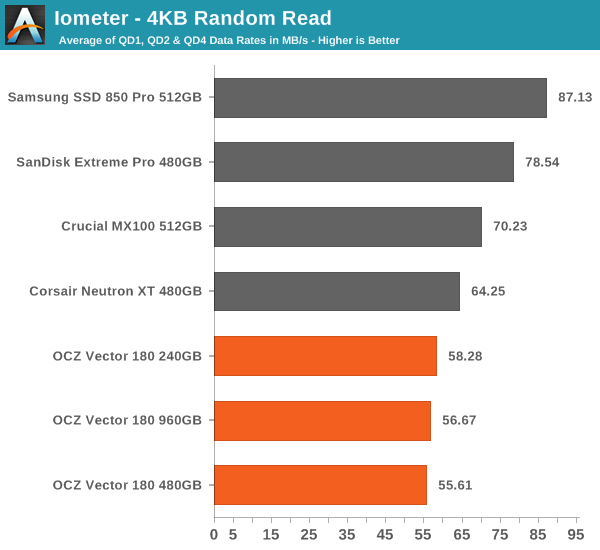
Random read performance at small queue depths has never been an area where the Vector 180 has excelled in. Given that these are one of the most common IOs, it's an area where I would like to see improvement on OCZ's behalf.
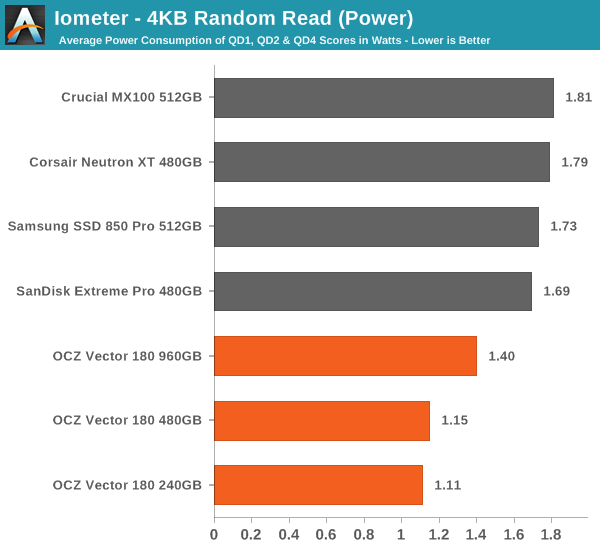
Power consumption, on the other hand, is excellent, which is partially explained by the lower performance.
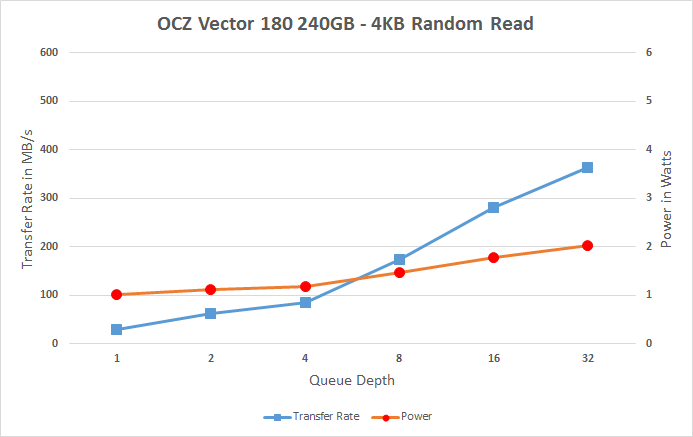 |
|||||||||
Having a closer look at the performance data across all queue depths reveals the reason for Vector 180's poor random read performance. For some reason, the performance only starts to scale properly after queue depth of 4, but even then the scaling isn't as aggressive as on some other drives.
Random Write Performance
Write performance is tested in the same way as read performance, except that the drive is in a secure erased state and the LBA span is limited to 16GB. We already test performance consistency separately, so a secure erased drive and limited LBA span ensures that the results here represent peak performance rather than sustained performance.
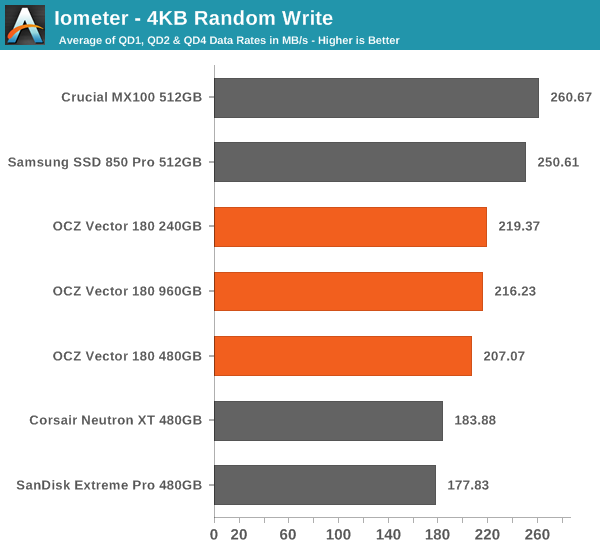
In random write performance the Vector 180 does considerably better, although it's still not the fastest drive around.
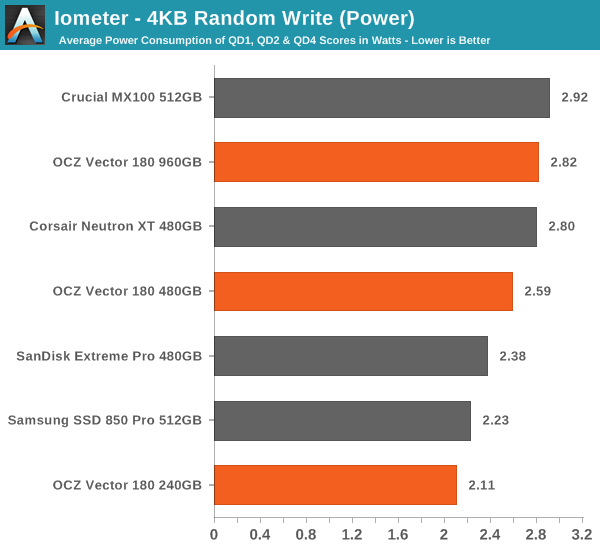
Even though the random write performance doesn't scale at all with capacity, the power consumption does. Still, the Vector 180 is quite power efficient compared to other drives.
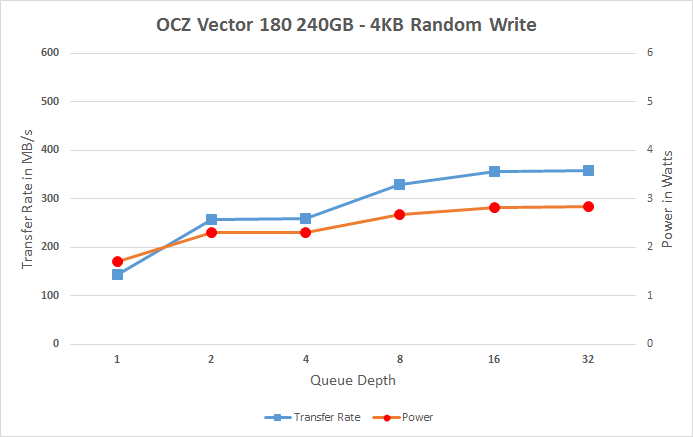 |
|||||||||
The Vector 180 scales smoothly across all queue depths, but it could scale a bit more aggressively because especially the QD4 score is a bit low. On a positive side, the Vector 180 does very well at QD1, though.










89 Comments
View All Comments
KAlmquist - Tuesday, March 24, 2015 - link
Vector 180 vx. MX 100:I think that the Crucial MX 100 will be a bit faster than the Vector 180 under typical usage, though the Vector 180 does outperform the MX 100 on some benchmarks. Both drives have partial power loss protection. The Vector 180 has a 5 year warranty vs. the 3 year warranty on the MX 100, but a lot of people will be looking to upgrade from SATA to PCIe SSD's before the 3 year warranty expires. In short, I don't see any reason to pay a premium price for the Vector 180.
MrCommunistGen - Tuesday, March 24, 2015 - link
If only HIPM+DIPM worked (yes I know its a hardware limitation of the platform) this looks like it'd be a great laptop SSD due to such low power consumption in the various workloads measured here.djsvetljo - Tuesday, March 24, 2015 - link
Two dead OCZ drives - there will never be a 3rd one. One of the drives was from the era of the bitcoins boom ( when they were easy to mine). Lost 150 coins there ( that's over $50 000). They stupid thing locked up due to power issues ( too many power cycles).STAY AWAY FROM OCZ
Antronman - Wednesday, March 25, 2015 - link
Well the thing is, the internals are drastically different right now.I've been in the market for a good SSD for a while. These drives seem to perform well. Sadly outperformed by the 850 Pro drives, but I do think that the enclosure is actually very aesthetically pleasing. If the cost could be driven down a lot, I'd be very interested in the 180.
mapesdhs - Wednesday, March 25, 2015 - link
You're right, they need to have a price advantage with the 180 to pull people in. Also,availability needs to be good - in the past it's been rather sketchy with the 150, which
means prices tend to creep up from a small number of suppliers.
Ian.
mapesdhs - Wednesday, March 25, 2015 - link
More than 30 OCZ drives, all working fine. Some had bad luck, others used Marvell portsand blame OCZ. It varies.
As for coins, well boohoo, not real money unless they're converted back to $.
Ian.
ocztosh - Monday, March 30, 2015 - link
Hi mapesdhs, thank you for your feedback and great to hear the drives are working well for you. We greatly appreciate both your business and support.FalcomPSX - Tuesday, March 24, 2015 - link
I've owned i think three OCZ drives in the past, they've all bricked on me within about a year. Never again will I purchase their shoddy products. While i was able to get warranty replacments each time, and the customer service is decent, the product itself is just not reliable in any way. I don't know if the new ones are improved at all, but i'm not risking MY data to find out.ocztosh - Wednesday, March 25, 2015 - link
Hello FalcomPSX, thank you for your comments and sorry to hear that you has a problem with previous drives. We are a new organization under Toshiba and have made significant changes to everything from processes to production. We understand how you feel and hope that one day we will have the opportunity to demonstrate the reliability of our current products. Thank you again for your feedbackNeatOman - Wednesday, March 25, 2015 - link
Battery backup should be built into the PSU for workstations and servers, google does this for their data centers.. why shouldn't servers and workstations. All you need is 1 minute for the average workstation to go into hibernation until power is back on IMO.